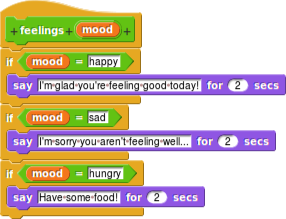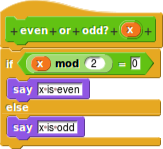Now that we have the idea of predicates under our belt, we can finally express full "if-then" statements,
such as "if the weather is nice, you should go outside." This can be expressed
in snap using the  block. Notice how the first slot is shaped just like a predicate block.
block. Notice how the first slot is shaped just like a predicate block. if blocks only know how
to handle yes/no questions, so you should only ever put predicate blocks into this slot. The C-shaped part
of the if block is where you put the commands that should be run if the condition is
true. Let's take a look at an example:

In the above example, we had several possible cases to consider. However, in many situations, there are only
two main cases. Take for example, the following sentence: "If a number is divisible by 2, it is
even. Otherwise it is odd." For these situations we have the  block. It works like this:
block. It works like this:

Here, we didn't need to have an additional "if," because all whole numbers are either even or odd. If the
boolean expression (x mod 2 = 0) evaluates to false, we know that the number is not even and
thus must be odd.
If you haven't seen the  block before,
it reports the remainder (or "modulus") when the first input is divided by the second. For example,
block before,
it reports the remainder (or "modulus") when the first input is divided by the second. For example, 5
mod 2 reports 1 because 5 / 2 = 2 remainder 1. This block is especially
useful for checking whether a number is divisible by another, because the remainder will be
0.  is the same as
asking if
is the same as
asking if x is divisible by 2 (i.e. that x is even).
 block. Notice how the first slot is shaped just like a predicate block.
block. Notice how the first slot is shaped just like a predicate block. 
 block. It works like this:
block. It works like this:

 block before,
it reports the remainder (or "modulus") when the first input is divided by the second. For example,
block before,
it reports the remainder (or "modulus") when the first input is divided by the second. For example,  is the same as
asking if
is the same as
asking if